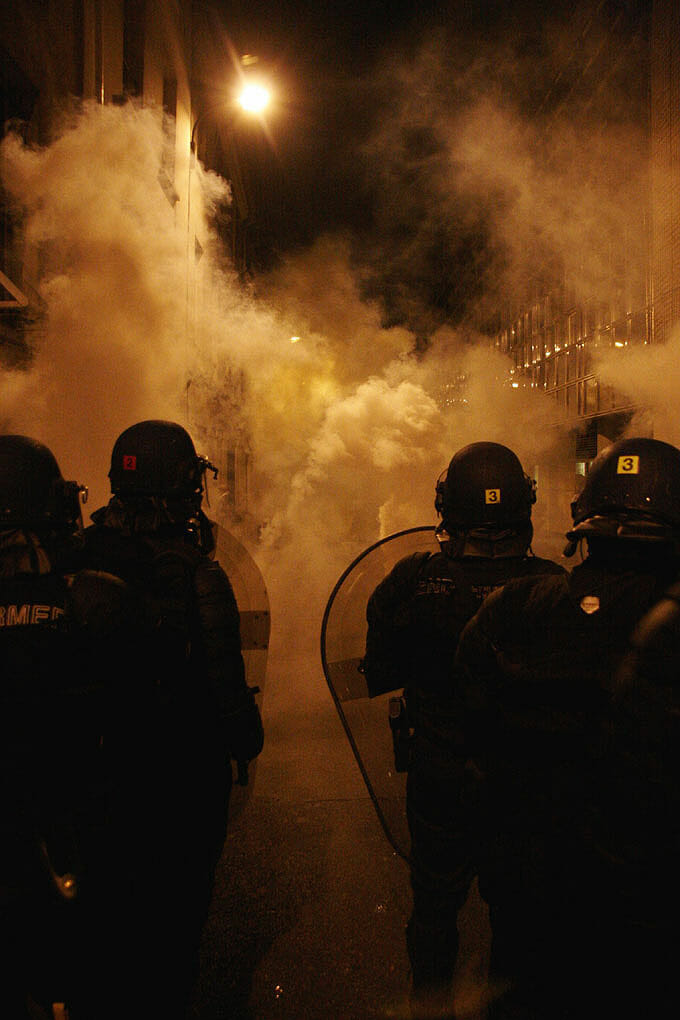S.W.A.T. USA

Sunday night in Ferguson, Missouri, the second night of an imposed curfew, brought not calm, but more chaos. The world watched the scene unfold on several online livestreams and read rapidly-changing reports over Twitter. (Broadcast television news was largely useless.) At 10 p.m. local time, two hours before curfew, what many witnesses say was a peaceful protest turned ugly when cops began advancing on crowds in armored vehicles and shooting tear gas canisters with dangerous force. We saw the painful-looking rubber-bullet wounds, and we heard the ear-splitting sound cannons.
The situation escalated quickly. Amanda Terkel of The Huffington Post, on the ground in Ferguson, wrote at one point in the evening, “#Ferguson feels like a party right now. Honking, music, dancing(ish). Loud.” Just twenty minutes later, she posted a photo of a child who had just been hit by a tear gas canister and then one of a photojournalist trying not to get shot. And keep in mind this was all before the New York Times released the autopsy report of Michael Brown, showing that the unarmed teen was shot six times, twice in the head.
How did we get here? How did an American suburb in 2014 become an occupied police state?
Back in 2001, Mike Newirth helped answer this question in issue 14 of The Baffler. In “Death Travels West, Watch Him Go,” a stinging analysis of the history of the NRA’s influence in America, Newirth discussed the strong ties between the gun lobby and law enforcement. Citing research from a book by journalist Tom Diaz, Newirth writes,
In the nineties, as Diaz recounts, police departments nationwide began to fear a perceived “gun gap” between their own long-standard .38 revolvers and the armaments available to the “bad guys.” And thanks in part to the fetishization of semiautomatics in Scarface and Miami Vice, there was some validity to this fear: Recall the 1986 Miami shootout in which two felons, armed with Magnum revolvers, a shotgun, and a .223 semiautomatic rifle, killed two FBI agents and wounded five even after being themselves wounded by 9 mm rounds. This had wide repercussions: Ignoring factors like agent unpreparedness, the FBI publicly denounced the 9 mm as insufficient for earnest firefights, and embarked on a sidearm review which, as Diaz documents, ushered into the civilian marketplace numerous new weapons in formerly obscure calibers. Law enforcement’s rush to over-powered ammunition had the unintended consequences one might expect from such a mixing of lethality and bureaucracy. Diaz digs up enough obscure stories—like the nest-feathering that Glock provided certain New York officials in order to promote two unnecessary upgrades—to suggest that law enforcement agencies foster gun technology proliferation even if their rhetoric officially opposes it.
A more insidious effect, perhaps rooted in the fact that many officers are required to range-qualify only twice a year, is the increasing incidence of what police call “spray and pray,” in which an officer squeezes off several rounds or the whole clip in response to real or perceived threats. It’s strange how quickly multiple-wound police shootings have assumed the cultural weight that ’banger drive-bys had in the eighties: poled TV lights and grim cops, enraged neighbors tragic in their shabby night-dress, a crystallized moment from a Richard Price novel.
Read the rest of Newirth’s piece here. (That same year, Newirth also wrote about police shootings in Los Angeles and Chicago in his piece “Cop Shoot Cop,” which you can read here.)
In The Baffler’s more recent memory, issue 23 had another important piece on the dangerous escalation of military equipment and tactics in local police forces. Here’s how Chris Bray’s “Street Legal: The national security state comes home” begins:
In the aftermath of the 1993 World Trade Center bombing, the 1995 Oklahoma City bombing, the 1996 bombing at the Atlanta Olympics, and the paired 2001 attacks on the World Trade Center and the Pentagon, here’s what didn’t happen: whole cities weren’t locked down, armored personnel carriers with police logos didn’t rumble in, and SWAT teams in combat uniforms and body armor didn’t storm through the suburbs for a loosely ordered set of (ultimately hapless) house-to-house searches. Somehow, though, 2013 was the year it became appropriate to close cities, turning off taxis, buses, and trains and telling residents that the governor was suggesting—okay, strongly suggesting—that they not leave their homes until the police said so. One of those familiar moments in which officials ask the public to be on the lookout turned into a remarkable new moment in which officials ask the public to cease to exist in its public form so that the police can have the streets.
Read the rest of Chris Bray’s piece here, and stay safe out there, everybody.